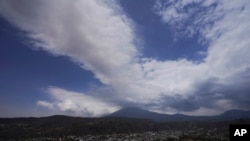On the banks of the town of Santiago Xalitzintla, one of the closest to the Popocatépetl volcano and far from the hustle and bustle of traffic, occasional rumbles from the mountain could be heard on Monday, like the roar of an engine.
As the name of the town (Xalitzintla in Nahuatl means “place of sand”) a very fine layer of ash fell on the place, enveloping everything in a mist that slightly reduced visibility while accumulating on the windshields of vehicles and on the skin of the passersby.
Activity at the 5,425-meter-high volcano, some 70 kilometers southeast of Mexico City, has increased over the past week with large columns of ash and gases and incandescent material, which forced the government to increase the alert level on Sunday. and close schools in dozens of municipalities in three states.
“At night you hear more,” said Violeta Fuentes, 39, who lives with her husband and their 9- and 12-year-old children on the outskirts of Santiago Xalitzintla. It is also the moment when they can see the glow of the crater. “Last night they went several times, at the moment it turned off and then turned on again.”
Fuentes acknowledged that she is somewhat restless “because it is seen that (the volcano) no longer wants to be well.” The family, like many of their neighbors, is concerned about the impact that ashfall may have on their crops.
The corn in his father-in-law’s plot, across the street, already had a light layer of ash and some farmers also feared that the animals would get sick from the remains that are deposited on the grass.
On Monday, authorities at the local, state and federal levels carried out drills against the possibility of evacuations and prepared shelters while the army checked that the routes were open and kept more than 6,500 troops on alert for any emergency.
All these preparations are nothing new for many of the local residents who live on the slopes of Popo, as all Mexicans call the volcano.
“We are not scared,” said Job Amalco, a driver who saw all the coming and going of civil protection members as normal. “We are spectators of what nature gives us,” he proudly declared.
But among some there were beginning to be signs of anxiety.
“It does worry, especially for children, because it is not known if there will be a huge or small explosion,” said Claudia de la Cruz, 27, mother of two children, ages 3 and 5.
Her husband climbs the slope of the volcano every day to collect firewood. “He says that over there you can hear the hills falling apart and he trembles, but he gets strong for us,” she commented.
De la Cruz recalled that she was just a child when she first saw the mountain glow and how the residents had very little information back then. She trusts that now that they have a cell phone they will be able to know what is happening in real time.
Either way, the only real warning that most people in these communities are heeding, as they have their entire lives, will be the urgent pealing of church bells.
On Monday they sounded as part of the drill but the neighbors remain calm. Many are most concerned about the possibility of evacuating and abandoning their homes and their animals. Authorities have warned residents to stay out of a 12-kilometer radius of the summit.
The volcano’s activity caused flights to be temporarily suspended at the two airports in the Mexican capital over the weekend because the ash clouds reduce visibility and can be abrasive for planes.
On Monday, an ash plume stretched hundreds of miles east to the Bay of Campeche, according to a report from the US National Oceanic and Atmospheric Administration Office.
The national coordinator of Civil Protection, Laura Velázquez, announced on Sunday that the volcanic traffic light, the instrument to inform the population, was still at an intermediate level, yellow, but was going up from phase 2 to phase 3 due to the activity registered since last Friday. . However, she stressed that “there is no risk to the population at this time.”
In this phase, large domes form on the mountain and explode with increasing intensity, spewing incandescent rocks into the air and pyroclastic flows.
Velázquez said that only three of the volcano’s 565 explosions since September had been large and that the current activity was not the largest this century. On Monday he supervised the drill in Santiago Xalitzintla.
Some 25 million people live within a 100-kilometer radius of the volcano, the majority in the metropolitan area of Mexico City.
El Popo has been active for more than half a million years but its current form arose about 20,000 years ago in the crater of other volcanoes and the last major eruption was more than 1,000 years ago.
The pre-Hispanic codices also speak of intense activity at the beginning of the 16th century, but in more recent times it is considered that the volcano awoke in 1994.
Subsequently, there have been periods of more intense activity between 2000-2003 and from 2012 to 2016, but only once, in 2000, did the emergency have to be raised to red, according to the National Center for Disaster Prevention of Mexico.
Connect with the Voice of America! Subscribe to our channel Youtube and activate notifications, or follow us on social networks: Facebook, Twitter and Instagram.


![[Img #74664]](https://thelatestnews.world/wp-content/uploads/2024/12/James-Watson-The-controversial-genius-behind-the-double-helix-150x150.jpg)










